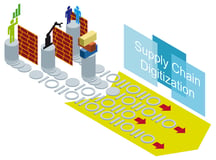The Challenges of Supply Chain Integration
Nick Ostdick - August 08, 2017

For all the bluster about the latest and greatest technological advancements and developments in today’s global supply chain management, it’s important to remember what the true essence of supply chain logistics revolves around: putting the right product in front of the right people at the right time. It may sound simplistic, but as global partner networks continue to expand and already variant-rich industries continue to diversify, it becomes increasingly difficult to execute a very basic premise.
One method planners and managers can pursue in the hunt for a more simple, less complex platform of supply logistics is supply chain integration. Whether it’s the sourcing of raw materials, assignment of planned production programs, transportation and warehousing, or delivery and customer management, companies in today’s automotive industry have realized the value-added proposition in integrating their supply chain across all touch points in order to fully control their overall supply situation and gain valuable insight into the functionality and efficiency of their value chain.
Full supply chain integration means much more than simply managing the movement of materials and resources and addressing logistical issues thereof. Rather, supply chain integration means an acknowledgement that production stages of the supply chain must exchange data, and analytics, and time-sensitive information in real-time with other points in the supply network.
But as with everything in global supply chain management, obstacles do present themselves as manufacturing companies work to fully integrated their supply chains. While these obstacles can be addressed and overcome, companies should be aware of these hurdles and their implications as they strive to align each touch point of their value streams. With this in mind, let’s examine a few of the most common challenges in supply chain integration and what these challenges mean for companies in engineering best practices for supply logistics.
Challenge #1: Collaboration across supply and partner networks
As we’ve discussed before, a common fixture for manufacturing companies in today’s supply stream consists of production facilities and hubs spanned out across the globe, creating an increasingly difficult network of production platforms to manage. End-to-end (E2E) visibility is critical in overseeing these networks and ensuring the right products are being produced at the right time at the right facility given various rules or restrictions. A fully-integrated supply chain allows planners and managers to make adjustments or modifications to planned production programs — often while component parts are in-transit or even during the pre-production stage — in real-time to secure on-time delivery, efficiency, and cost-effectiveness.
Challenge #2: Transparency of material flow and inventory status
Because of a number of intelligent planning software solutions and strategies such as BOM management, Plan for Every Part (PFEP), Every Part Every Interval (EPEI), and container management strategies, a fully-integrated supply chain allows planners and managers to view, track, and modify the movements of parts, inventories levels, and container pull strategies based on demand or production levels. The sharing of information between the sales and planning stages of the value chain also allows for manufacturing companies to create more accurate forecasting based on previous performance to ensure coverage levels are met and productions can continue as scheduled.
Challenge #3: Agile production network architecture
It’s no secret that one of the most important bottom lines in today’s automotive supply stream is the ability to adapt to changing parameters of production, fluctuations in inventory or material levels, and bottlenecks or disruptions. If we think of an integrated supply chain as a game of telephone where there’s no variation in what is said between the players, it’s easy to understand how the sharing of valid, up-to-date, and detailed information is critical in promoting a robust production platform capable of withstanding on-the-spot modifications and alterations. Accuracy of data and information is perhaps at the core of creating a nimble, responsive production network.
Challenge #4: Real-time communication and data analysis
Imagine a planned production program calls for X number of parts to be pulled from a container in the yard; however, after the pull has been ordered, the customer requests an alteration to the order requiring fewer parts from the container. In a time before intelligent planning solutions and integrated supply chain concepts, this modification could mean a significant disruption as more time and resources would be needed to make the adjustment. But with a fully-integrated supply chain where players can communicate data or product information in real-time, planners and managers can adapt to this order fluctuation the moment it happens to pull the right quantities of parts from the right container in the right fashion.
If you want to learn more get your Guide to Industry 4.0:
LATEST POSTS
- Understand Circular Economy in The Manufacturing Industry
- How Can Industry 4.0 IT Integration Be Achieved Smoothly?
- The Significance of Order Sequencing in Discrete Manufacturing
- How to improve your Supply Chain Management: The Power of Control Towers
- Optimizing Human Resource Scheduling in Manufacturing: A Technological Approach



